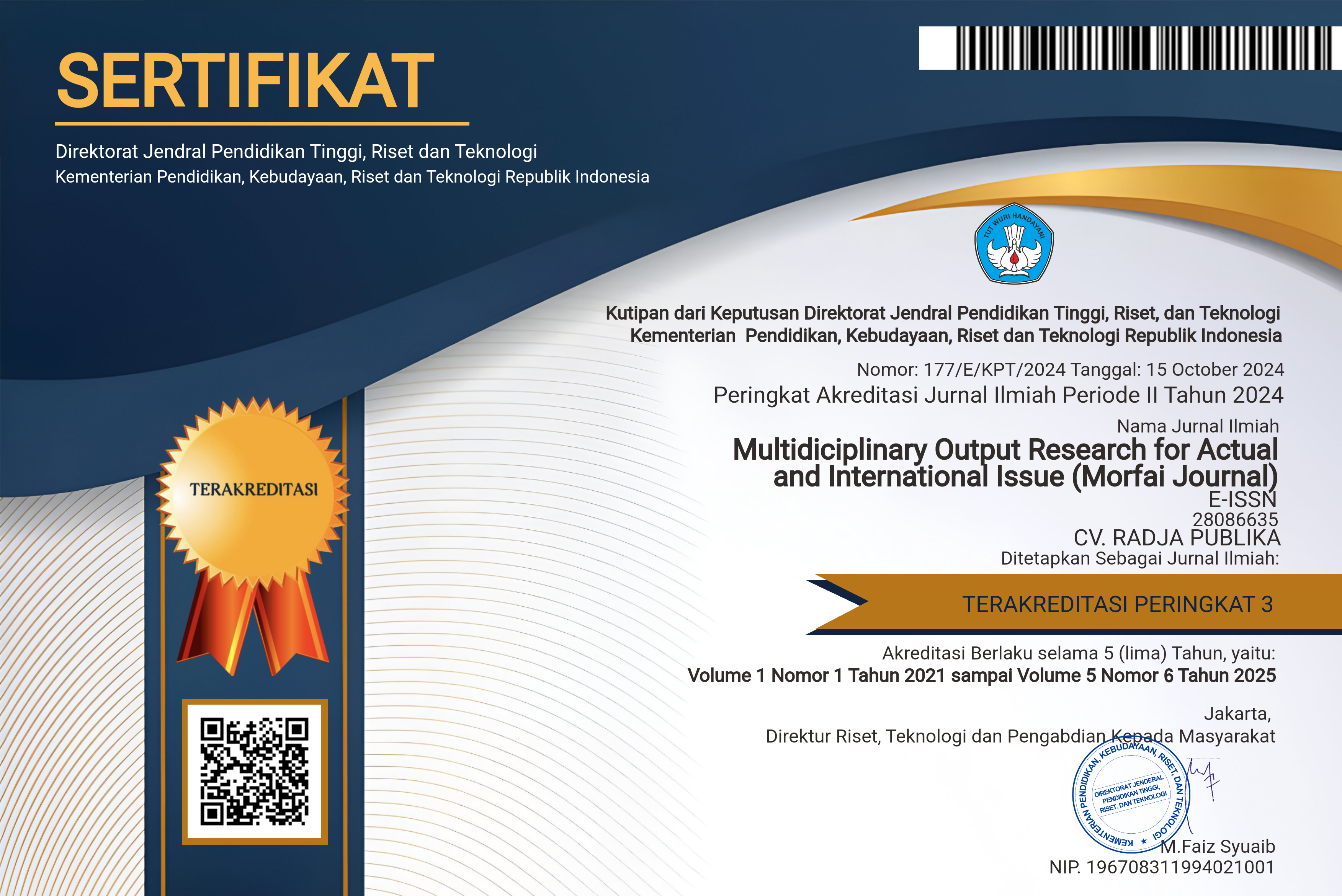"IMPLEMENTATION OF CRIME PREVENTION THROUGH ENVIRONMENTAL DESIGN IN MELIA RESIDENCE HOUSING, SOUTH TANGERANG"
DOI:
10.54443/morfai.v5i6.3374Published:
2025-07-13Downloads
Abstract
Residential areas have begun to implement a security system using a one-gate system and strict patrols. These facilities are supported by guards or security personnel to ensure the safety of the residential area. This research is expected to contribute to the development of studies in the field of criminology, especially related to the application of the Crime Prevention Through Environmental Design (CPTED) approach. The author acknowledges that by using a descriptive qualitative research type, it is possible to find out how crime prevention strategies and the implementation of CPTED are implemented as an effort to prevent crime in the Residential Areas. Qualitative research itself also allows researchers to conduct direct interviews with sources who will help in collecting data on the issues being researched. This research is related to Ronald V Clarke's Situational Crime Prevention (SCP) Theory, where Situational Crime Prevention and CPTED can complement each other to prevent crime in Residential Area. This theory aims to explain the application of CPTED as a Crime Prevention Strategy so that criminal acts become more difficult to commit. The results of this study can be used as evaluation material and consideration in designing housing environment infrastructure to be safer through CPTED principles.
Keywords:
Crime Prevention Strategy, Environmental Design, Residential Area, Security Personnel, Security SystemReferences
Affif, A. M., & Novrial. (2021). Implementasi Crime Prevention Through Environmental Design (CPTED) Pada Fasilitas Parkir Sepeda Motor (Studi Kasus: Kampus Fakultas Ilmu Budaya USU). TATA LOKA Vol 23 No.1, 127-137.
Amin, A., Bhuiyan, A. B., Mohan, N. M., & Alias, Z. (2025). The Effects of People’s Housing Programme (PHP) and Crime Prevention through Environmental Design (CPTED) on the Residential Environment on Quality of Life in Malaysia. INTERNATIONAL OF ACADEMIC RESEARCH IN BUSINESS & SOCIAL SCIENCES Vol 15, Issue 01, 1178-1191.
Aulia, D. N., & Mahwani, Y. E. (2020). The implementation of the Crime Prevention Through Environmental Design (CPTED) concept on Taman Setiabudi Indah 1 Estate, Medan City, Indonesia. IOP Conference Series: Earth and Environmental Science, 1-11.
Crowe, T. D. (2013). CRIME PREVENTION THROUGH ENVIRONMENTAL DESIGN. Oxford: Elsevier.
Desias, W., & Dewi, D. K. (2019). DESAIN LINGKUNGAN KAMPUNG KALI CODE DALAM PENCEGAHAN KRIMINALITAS BERDASARKAN PERSEPSI MASYARAKAT. Jurnal Ilmiah Arsitektur dan Lingkungan Bin vol 17, No.2, 131-140.
Dulkiah, D. H. (2020). SOSIOLOGI KRIMINAL. Bandung : LP@M UIN SGD Bandung.
Erviana, I. (n.d.). TINDAKAN KRIMINALITAS. Jurnal Universitas Negeri Makassar.
Fadli, M. R. (2021). Memahami desain metode penelitian kualitatif. Humanika, Kajian Ilmiah Mata Kuliah Umum Vol. 21. No. 1, 33-54.
Hapsari, D. O., & Susanti, R. (2019). Penilaian Kualitas Desain Perguruan Tinggi dengan Menggunakan Pendekatan CPTED di Kota Semarang. Ruang Vol 5 No.1, 20-31.
Hidayat, A. (2024). Minimizing Misuse of Public Toilets with Design Based on Criminal Prevention Through Environmental Design (CPTED). Journal of Darma Cendika Catholic University , 58-63.
Ihsan, K. (2016). FAKTOR PENYEBAB ANAK MELAKUKAN TINDAKAN KRIMINAL (Studi Kasus Lembaga Pemasyarakatan Pekanbaru Kelas II B). JOM FISIP Vol. 3 No. 2, 1-15.
Malik, A. A., Sela, R. L., & Moniaga, I. L. (2024). Implementation of Crime Prevention Through Environmental Design (CPTED) in Manado oldy city center area. Jurnal Teknik Arsitektur, Vol 9 Issue 2, 209-216.
Mandey, Y. M., Malik, A. A., & Rengkung, M. M. (2020). Manifestasi Paradigma Crime Prevention Through Environmental Design (CPTED) di Kawasan Pusat Kota Lama Manado dan Hubungannya dengan Tingkat Kriminalitas. Jurnal Fraktal Vol.8 No.1, 27-34.
Masnur, Alam, S., & Nasir, M. F. (2021). RANCANG BANGUN SISTEM KEAMANAN MOTOR DENGAN PENGENALAN SIDIK JARI BERBASIS ARDUINO UNO. JURNAL SINTAKS LOGIKA Vol. 1 No. 1 , 1-7.
Munggaran, b., & Navastara, A. M. (2018). Pengaruh Implementasi Variabel Crime Prevention Through Enviromental Design terhadap Persepsi Rasa Aman Penghuni Perumahan Wisma Permai Timur Surabaya. JURNAL TEKNIK ITS Vol. 7, No. 2, 199-205.
Nurlaela, S., Sugiono, Ismiralda, N. A., Navastara, A. M., Umilla, E., & Koswara, A. Y. (2021). Assessment of the Perception of Security Based on Crime Prevention through Environmental Design in Bundaran HI. TATA LOKA Vol 23 No.4, 536-552.
Pasaribu, R. G., Mulyadi, & Wulan, G. A. (2020). Pencegahan Kejahatan Ujaran Kebencian di Indonesia. Jurnal Ilmu Kepolisian Vol.14 No.3, 170-188.
Rahmatia, L. Z., Priyanto, S., Syauqillah, M., & Subandi, I. (2024). Evaluasi Sistem Pengamanan Kantor Kepolisian Negara Republik Indonesia:Studi Kasus Sistem Pengamanan di Polsek X. UNES Law Review Vol.6 No.4, 48-59.
Rozhan, A., & Mohd Yunos, M. Y. (2019). Crime Prevention Through Environmental Design: A Review on Potential Improvement in its Concept for a Safer City. International Journal of Engineering & Technology, 537-540.
Sakina, B. (2020). A study on crime prevention through environmental design concept application in a private house in Yogyakarta, Indonesia. IOP Conference Series: Earth and Environmental Science, 1-6.
Santoso, A. K., De Yong, S., & Tedjokoesoemo, P. E. (2018). Kajian Terapan Konsep Crime Prevention Through Environmental Design (CPTED) pada Interior Rumah Tinggal Tipe Semi-Detached di Sidoarjo. JURNAL INTRA Vol. 6, No. 2, 797-806.
Scneider, R. H., & Kitchen, T. (2017). PLANNING FOR CRIME PREVENTION. New York: Routledge.
Suryani, B. (2023). KRIMINOLOGI. Medan: Universitas Medan Area Press.
Swanson. (2013). Theory building in applied disciplines. San Francisco.
Syahid, A., Sadika, F., & Pambudi, T. S. (2020). PERANCANGAN PRODUCT ATTACHMENTUNTUK PENCEGAHAN TINDAK KRIMINAL PADA KAFE DENGAN PENDEKATAN KONSEP CPTED. e-Proceeding of Art & Design : Vol.7, No.2, 5365-5377.
Syauqi, A., Radja, A. M., & Wikantari, R. (2024). Crime Prevention Through Environmental Design: Visitors’ Perceptions of Safety at the Vernacular Coastal Tourism Destination Palippis in Indonesia. ISVS e-journal, Vol. 11, Issue 10, 105-121.
Wachyudi, A. Y., & Iftironi, M. (2019). KAJIAN SIRKULASI KAWASAN DENGAN PENDEKATAN CPTED (CRIME PREVENTION THROUGH ENVIRONMENT DESIGN) SEBAGAI UPAYA MENANGGULANGI TINDAK KRIMINALITAS PADA KAMPUNG MRICAN YOGYAKARTA. Sakapari, 196-209.
Wahyudi, R., & Priyanto, S. (2022). Prevention Of Terrorism Attacks Through Environmental Design In Indonesia Airport. Journal of Terrorism Studies Vol.4 No.1, 1-15.
Wekke, I. S. (2019). METODE PENELITIAN SOSIAL. Gawe Buku.
Wizaka, W. (2012). ADAPTASI CRIME PREVENTION THROUGH ENVIRONMENT DESIGN (CPTED): STUDI KASUS FENOMENA DESAIN FASILITAS PUBLIK. ComTech Vol.3 No.1, 51-58.
Yusoff, N. H. (2020). The need of crime prevention through environmental design (CPTED) to prevent misbehaviour among Malaysia football fans. Journal of Xi'an University of Architecture & Technology Vol XII, Issue IV, 3803-3808.
License
Copyright (c) 2025 Reyhan Taufiq Ramadhan, Muhammad Zaky

This work is licensed under a Creative Commons Attribution 4.0 International License.











